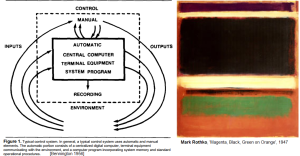1961. Robert McNamara, the recently installed Secretary of Defense in President John Fitzgerald Kennedy’s cabinet, sits in his Pentagon office at a nine-foot-long mahogany desk, polished to a mirrorlike shine. He is wearing a dark suit, his thick brown hair slicked back on his head and parted in the middle, old fashioned wire-rim spectacles framing his mirthless eyes, his jaw clenched tight, a severe expression on his face, looking very much the Presbyterian elder he is.
The door opens, and Edward Lansdale, career spy and counterinsurgency specialist, enters. He has handsome, movie star good looks and a neat moustache. A look of determination is on his face, with a hint of a maverick smile, and he is carrying a box of what seem to be weapons and camping gear, caked with mud and even blood.
MCNAMARA is making notes on some graph paper.
MCNAMARA: [Stiffly] Colonel Lansdale, good to see you.
LANSDALE: Good morning, Mr Secretary.
MCNAMARA: Lansdale, we’re doing a systems analysis on our policy in South Vietnam. I understand you’ve just returned from a trip there and I need your report on the situation. You have nine and a half minutes for this briefing.
LANSDALE strides over to the desk and upends the content of the box. Out spill handmade pistols and knives, old French rifles, and bamboo punji sticks, all over the desk with a clatter, with a few falling on the floor.
LANSDALE: The enemy in Vietnam uses these weapons – and they were using them just a little bit ago before I got them. Many of them are barefoot or wear sandals. They wear black pajamas, usually, with tatters or holes in them. I don’t think you’d recognize any of them as soldiers, but they think of themselves that way. The people that are fighting there, on our side, are being supplied with our weapons and uniforms and shoes and all of the best that we have; and we’re training them. Yet, the enemy is licking our side. Always keep in mind about Vietnam, that the struggle goes far beyond the material things of life. It doesn’t take weapons and uniforms and lots of food to win. It takes something else, ideas and ideals, and these guys are using that something else. Let’s at least learn that lesson.
MCNAMARA stares at his soiled desk, blinking.
MCNAMARA: I see. [Stands up.] Colonel Lansdale, you can’t substitute emotions for reason.
LANSDALE: [Chuckles] It substituted just fine when we made those Marxists on Luzon think their villages were attacked by vampires.
MCNAMARA, somewhat fussily, fishes out his graph paper and pencil from under the weapons and other junk now on his desk. He walks to a clearer part of the desk and places it down.
MCNAMARA: Lansdale. As I said before, we are performing an extensive systems analysis on the situation in South and North Vietnam, and very much need to capture all the factors at play. I’m not sure if you are familiar with systems analysis. This is a process we used when I was an executive at Ford Motors. I have a list of seventy three factors our staff have so far found, including food supply, ammunition, rice production, oil imports, and so on. We’ll crunch the numbers, and once the analysis is complete, the output of the model will give us a clear path to victory.
LANSDALE glances at the list.
LANSDALE: Mr Secretary, your list is incomplete. You’ve left out the most important factor of all.
MCNAMARA: What is it?
LANSDALE: Well, it’s the human factor. You can put it down as the X factor.
MCNAMARA writes down “X Factor” on the graph paper.
MCNAMARA: What does it consist of?
LANSDALE: What the people out on the battlefield really feel; which side they want to see win and which side they’re for at the moment. That’s the only way you’re going to ever have this war decided.
MCNAMARA: Ah. Good point, but we’ve got that actually. Over here, see: “Volunteer signups”, “Ho Chi Minh “uncle-ization” ratio”, “Negative reviews on Saigon embassy facebook page”, “Mao Zedong cat pun frequency”, “GI sales of Conrad short stories”.
LANSDALE: I see. Well, what about the V factor?
MCNAMARA writes down “V Factor” on the graph paper.
MCNAMARA: What does it consist of?
LANSDALE: Vampires.
MCNAMARA: Ok. Ah, we’ll make sure to give that, uh, the appropriate weighting.
LANSDALE: Mr Secretary, there’s no mathematical formula for the human spirit.
MCNAMARA: That’s true. Some of those smart IBM boys we seconded from Cambridge found that a fifteen dimension vector including poetry writing and fish sauce consumption was a passable proxy in the Indochinese context, though.
LANSDALE: Oh, ok. Well that sounds just dandy. Don’t forget there are three brands of fish sauce popular in the south though – you should really track the lot.
MCNAMARA: Interesting. I’ll put those IBM boys onto it.
LANSDALE: Good.
MCNAMARA: Good. This has been really useful, but I’ve got something else to do now. Oh, by the way, the intern you put on the Saigon embassy Twitter account is going great. The analytics are through the roof!
LANSDALE: [Snaps fingers, points back to MCNAMARA and smiles winningly.] I’ll pass it on.
MCNAMARA: Thanks Ed.
LANSDALE: Thanks Bob.
—
Rather loosely adapted from Chapter 22 of Max Boot’s recent biography of Lansdale, The Road Not Taken.
—
References
Boot – The Road Not Taken: Edward Lansdale and the America Tragedy In Vietnam
Brecher, Ames – War Nerd Podcast Episode 39
McNamara – In Retrospect
Wintermute, Boot – Max Boot interview on The Road Not Taken

